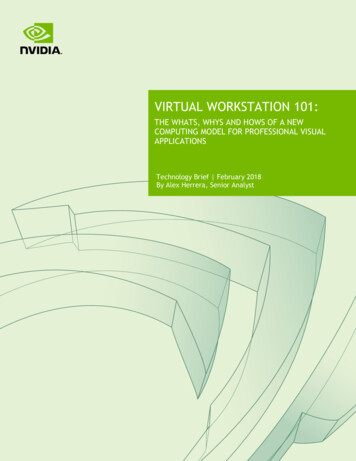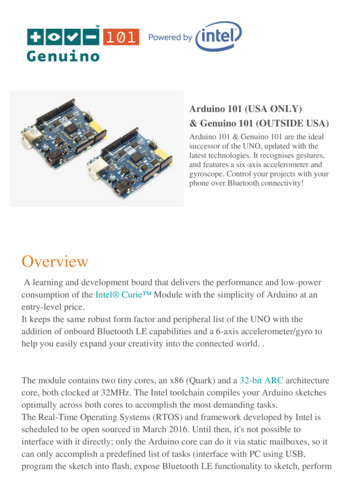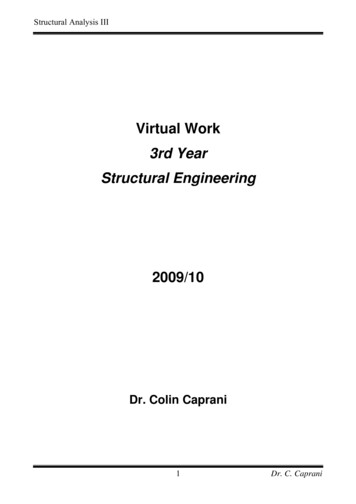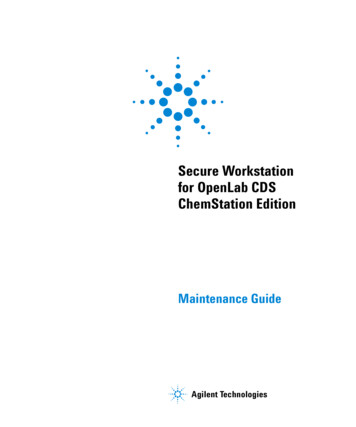
Transcription
VIRTUAL WORKSTATION 101:THE WHATS, WHYS AND HOWS OF A NEWCOMPUTING MODEL FOR PROFESSIONAL VISUALAPPLICATIONSTechnology Brief February 2018By Alex Herrera, Senior Analyst
VIRTUAL WORKSTATION 101Word is spreading fast about the unique value offered by the virtual workstation, andfor good reason. While professionals that require high-performance graphicalcomputing can and will still rely on traditional deskside and mobile workstations, there'snow a new model to consider. It's one that merges the proven server-based computingmodel with modern platform virtualization, combined with one critical new piece oftechnology: the virtualized GPU. Businesses now have a compelling new tool to attacksome of the most troublesome issues facing demanding visual computing applications.The virtual workstation has arrived.TRADITIONAL COMPUTING MODEL COMING UNDERINCREASED PRESSUREToday, the vast majority of professional, visually-intensive workflows run on acomputing environment built on a distributed sea of physical deskside and mobileworkstations. Users design, view, model, animate and simulate on their own machines,each responsible for computation, visualization and storage. It’s the de facto solution forone simple reason: it does its job, and it does its job well. And for the majority ofprofessionals that rely on high-performance visual computing — from CAD to AEC, fromfinance to energy, and from sciences to media and entertainment — the tried-and-truemobile and deskside workstations will effectively carry the workload well into theforeseeable future.Figure 1 In the traditional client-side model, each physical workstation is responsiblefor all end-user computes, graphics and dataTechnology Brief: Virtual Workstation 101 (February 2018) 2
But some businesses are finding challenges with the traditional workstation model,challenges that aren’t going away but instead intensifying over time. They’re seeingvisualization and computing, performed exclusively on clients spread across both thebusiness and geography, starting to creak under increasing pressure — from datasetsskyrocketing in size and heightened security concerns, to an increasingly distributedworkforce that needs fast access to always up-to-date project databases. Huge files areno longer taking seconds to ship from client to client, but instead minutes or evenhours. The risk of security breaches continues to climb, while maintaining that securityin an increasingly mobile world gets harder and harder. And complex projects are moreoften requiring teams assembled not just from employees, but contractors andconsultants who may not reside in the next cubicle, but on the other side of the globe.They might be in the office or out in the field. Yet, all need access to the same datasets,when they need it, from where they are and guaranteed up to date, with no waiting.VIRTUAL WORKSTATIONS: A NEW TAKE ON PROVENTECHNOLOGY AND INFRASTRUCTUREFor those cases, it’s not the capabilities of a traditional workstation that presents issues,but rather where those capabilities reside and how they’re accessed and shared. In theend, it’s the environment and topology that’s getting in the way for some, as adistributed sea of physical machines is fundamentally ill-equipped to addressincreasingly common challenges high-demand business are facing. Where to turn? Morethan a few are discovering the appeal of a centralized, server-side computing approach,one that merges the established foundation of platform virtualization technology butwith one critical new addition: the virtualizable GPU. The combination opens up theadvantages of a shared, centralized computing environment to an entirely new set ofusers: those whose jobs and business depend on interactive 3D graphical computing.Enter the virtual workstation.With the traditional, distributed client-side model that now dominates professional,visually-intensive computing, all user processing and rendering is performed locally bythe client. But with a virtual workstation approach, a remote server hosts a virtualrepresentation of that machine, performing not only the computation but the graphicsprocessing as well. Only the final displayed image — the pixel stream — traverses thenetwork, to a simple client that need only display those pixels and capture user I/O.Technology Brief: Virtual Workstation 101 (February 2018) 3
Figure 2 With virtual workstations hosted in the datacenter, all compute, data andgraphics reside on the server and clients receive only the pixel streamsNVIDIA Quadro Virtual Data Center Workstation (Quadro vDWS)turns the standard virtual desktop into a 3D virtual workstationNow virtualization technology and virtually hosted desktops aren’t particularly new.Business executives and IT administrators alike have been long enamored with platformvirtualization technology, and rightfully so, replacing PCs with very modest graphicaldemands with virtual desktops. The advantages of hosting virtual desktops remotely inthe data center are well-known and precisely the reason the most common form, VDI(Virtual Desktop Infrastructure) has grown from nothing to a multi-billion dollar businessin short order.What is new in the field of platform virtualization, however, is the ability to deliverworkstation-caliber, GPU-accelerated 3D graphics performance. NVIDIA Quadro vDWSallows host servers to now render 3D graphics for multiple hosted machines far fasterthan a conventional CPU-only server. Virtualized GPU processing turns a generalpurpose virtualized server into one capable of a hosting workstation-caliber virtualmachine, what is better called a virtual workstation.Technology Brief: Virtual Workstation 101 (February 2018) 4
VIRTUAL WORKSTATION DEPLOYMENT:CONSIDERATIONS AND CAVEATSThe ability of a virtualized workstation environment to keep one set of data safely in oneplace, accessible by anyone who needs it and authorized to have access, gets reallyattractive when you think about the explosion in the size of project datasets many arestruggling with. With a virtualized, centralized IT environment, your workforce doesn’tneed to be in the same building or even in the same country or time zone. Withpotentially massive, global teams comprised of employees, contractors and partnersalike, success hinges on the ability for IT to efficiently connect people to the data,without costly, time-consuming copies and downloads.Since machines don’t get physically moved around — instead just virtually anddynamically allocated — IT administration gets faster, simpler and less error-prone.Deprovisioning one user while provisioning another is fast, making rapid expansion andcontraction over a project's life far less problematic. The centralized control andmanagement consoles can dramatically simplify and streamline administrationoverhead, particularly for geographically dispersed enterprises. And orchestrating adisaster-tolerant environment (with a remote shadow datacenter, for example), avoidsthe risk of a single outage in some satellite office shutting down an entire globalenterprise.By its very design, the use of virtual workstations instantly hardens corporate security.No longer will staff be taking source data out of the office on laptops and flash drives.Only the pixels cross corporate firewalls, and those pixel streams can be (and typicallyare) encrypted. Better still, most any device is theoretically capable of receiving thatstream, allowing staff to safely employ personal devices like smartphones, tablets orMacs.But while the benefits of the virtual workstation make it a compelling option for all whorely on professional computing spaces to consider, it's neither a universal answer nor aone-size-fits-all solution. Virtual workstations might represent a replacement todeskside machines, an add-on to a traditional client-side environment, or none of theabove. Which situations call for virtual solutions, and which are probably best left (atleast for now) to physical ones? Ultimately, answers to these questions depend largelyon who you are, what you do, and how you work. Some key decision criteria to considerinvolve the size and organization of staff, dataset characteristics, network infrastructure,the makeup and requirements of your current IT environment, and the priority of issueslike security and disaster recovery. A physically scattered workforceThe more physically scattered your workforce, be it global, at the office, home oron the road, the more appealing a virtual workstation solution. Frequent third-party contributorsTechnology Brief: Virtual Workstation 101 (February 2018) 5
Businesses frequently bringing in contractors and consultants in and out of theworkflow will value the 24/7 remote access and ability to dynamically provisionand deprovision virtual workstations. Big datasets with many collaboratorsWorkflows with big datasets and many contributors are more likely to value the24/7 remote access to centralized data. More vulnerable to security breaches with catastrophic consequencesEvery business is concerned about security of IP, but companies morevulnerable, and for whom a breach would be catastrophic, particularly value theinherent security of a virtual solution, where data never strays beyond corporateor cloud firewalls. Very low disaster toleranceNo business wants outages and long recovery times due to natural disaster, butfor some the probability might be substantially higher and the penalties far moresevere. Access to high-performance network infrastructure.Moving to a remotely-hosted virtual workstation environment places a differentburden on a network, and not just any will suffice. High, reliable bandwidth andconsistent low round-trip latencies are key. Certification for mission-critical softwareSince most virtual workstations run a native binary for client operating systemslike Windows, they are inherently compatible with applications that run on thoseoperating systems. However, you’ll want to make sure your mission-criticalapplications are certified and supported for use on virtual workstations. For a listof workstation applications certified for NVIDIA virtual GPU-poweredenvironments, see NVIDIA Virtual GPU Technology. Little reliance on exotic or high-performance peripheralsVirtual platforms have a more difficult time supporting the full range ofperipherals, and high-demand I/O can impact visual performance. Tasks andworkflows with more pedestrian peripheral requirements are a better fit forvirtual workstations.Don’t feel this describes your organization and workflow? Then you're probably betteroff sticking with traditional physical workstations, at least for now. But if you find you’rechecking off most items, and more than a few represent hot-button issues, then it'sprobably worth dipping your toes in virtual waters, gradually and judiciously.Technology Brief: Virtual Workstation 101 (February 2018) 6
Whether to adopt virtual workstations — and if so, which types — depends on abusiness's computing needs, priorities, resources and philosophy. For most, the virtualworkstation won't represent a rip-and-replace proposition but rather a compellingcomplement to the existing and capable means we already have at our disposal.Ultimately, the advent of the virtual workstation adds another powerful weapon to ITarsenals, one that can be used to replace or complement physical workstations forsituations that warrant the move, while allowing visual professionals to continue relyingon traditional workstations for situations that don't.Technology Brief: Virtual Workstation 101 (February 2018) 7
Technology Brief: Virtual Workstation 101 (February 2018) 7 Whether to adopt virtual workstations — and if so, which types — depends on a business's computing needs, priorities, resources and philosophy. For most, the virtual workstation won't represent a rip-and-replace proposition but rather a compelling










